The 8 most incredible places to visit in Jordan

Nov 28, 2023 • 9 min read
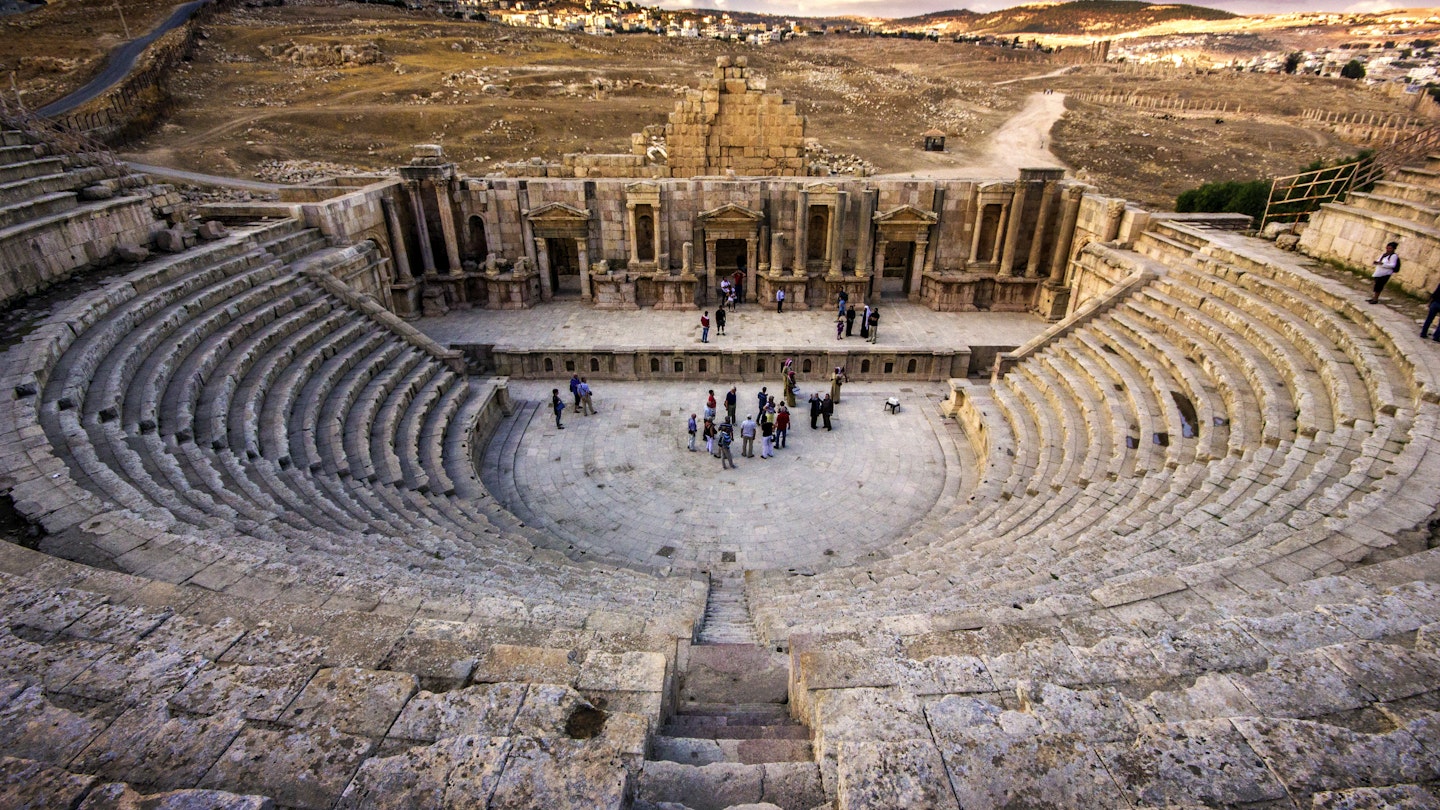
Explore the very best of Jordan with this guide to the top places to visit © Hamdan Owidah / 500px
There are many good reasons to put Jordan on your travel wish list.
Beyond the well-known (and justly famous) cliff-carved city of Petra , visitors here can explore the friendly villages and forested trails of Jordan’s north, the ancient ruins in Amman , and the mind-bending Mars-like desertscapes of Wadi Rum . Jordan is a fabulous destination for travelers with an adventurous spirit and an interest in Arab history and culture.
The intensity here – of the weather , traffic and terrain – can be overwhelming for first-time visitors , yet if you let go of your expectations and embrace all that Jordan offers, you’ll find warm hospitality and unique experiences that you’ll treasure forever.
Each of Jordan’s regions offer destinations with much to see and do (and eat!). Here are eight of the best places to visit in Jordan.

1. Umm Qais
Best place for hiking and nature
Located about two hours north of Amman, Umm Qais is an ideal base for exploring northern Jordan with its forested trails, farm-to-fork meals, warm hospitality and archaeological sites complete with sweeping views of the surrounding area.
We recommend seeking out local experiences (from an experienced operator like Baraka Destinations ) – imagine exploring the Greco-Roman ruins of Gadara , foraging with a local farmer, cooking with a Jordanian chef, cycling the countryside with a local guide or harvesting honey with a local beekeeper. This variety of activities means Umm Qais is an excellent destination for all types of visitors, including families, couples and solo travelers.
Nature lovers and hiking enthusiasts will be spoiled for choice, too, with the Yarmouk Forest Reserve – a favorite of savvy locals like mountaineer Mohammed Ziad Abdullatif – within easy reach. Abdullatif suggests hiring a local guide through the Royal Society for the Conservation of Nature or a tour operator such as Baraka Destinations. An expert can introduce you to the flora and fauna, and (if you’re lucky) prepare shai (tea) to share in the shade of the deciduous oak trees that grow here.
Planning tip: Umm Qais is also the starting point for the Jordan Trail . You can book a guided day hike from here to Arab Dam – we recommend Experience Jordan . Trek this northern section in the springtime for the highest chance of seeing the region carpeted in wildflowers.
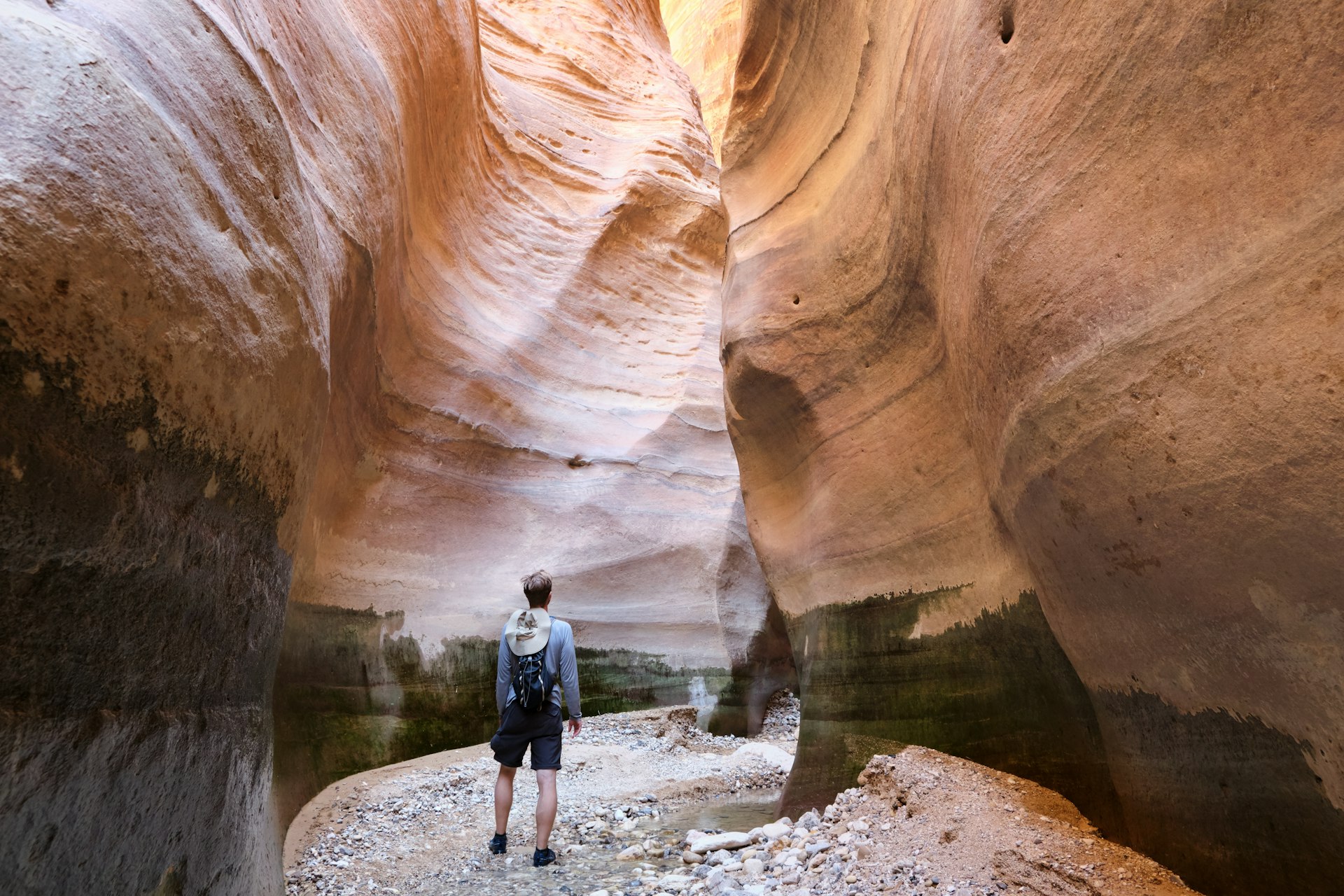
2. Dana Biosphere Reserve
Best region for nature and wildlife
Dana Biosphere Reserve , Jordan’s largest, contains mountains, wadis, more than 600 plant species, nearly 200 bird species, rare mammals such as the Syrian wolf and Nubian ibex and an archaeological site. Local hikers recommend this area for its unique ecology, varied terrain, incredible views and serenity.
Visitors can make Feynan Ecolodge their home base before connecting with Bedouin culture and the land through locally led experiences such as grazing goats with a shepherd, hiking in the wadis with a Bedouin guide, baking arbood bread, learning about medicinal plants and making Arabic coffee over a fire.
For intrepid travelers looking to stay out under the stars, multi-day hikes in Dana and on the Jordan Trail’s Dana-to-Petra section can be arranged.
Best place for archaeology fans
An easy day trip from Amman, Jerash is home to Gerasa , one of the best-preserved Roman cities in the Middle East. You don’t have to be a history or archaeology buff to appreciate the beauty of this impressive site, but it is helpful to hire a guide either on-site or in advance through a tour operator such as Engaging Cultures , as signage is limited.
Since the Forum , lined by stone columns, is a can’t-miss and is best viewed from above, be sure to take the steps up to the Temple of Zeus for a panoramic view of the ancient city, with modern-day Jerash in the background.
This region is also known for superior olives and olive oil, with some of the olive trees believed to be hundreds of years old. If you’re traveling to Jordan in September or October, book a multi-day trip with Engaging Cultures that includes an olive harvest experience, lunch and an overnight stay with a local family in nearby Orjan, as well as a visit to Ajloun Castle .
Planning tip: The site at Jerash is vast, so plan accordingly. Count on a minimum of three hours to see the main sights, plus additional time to explore more and take photos. Wear comfortable shoes and bring sun protection.
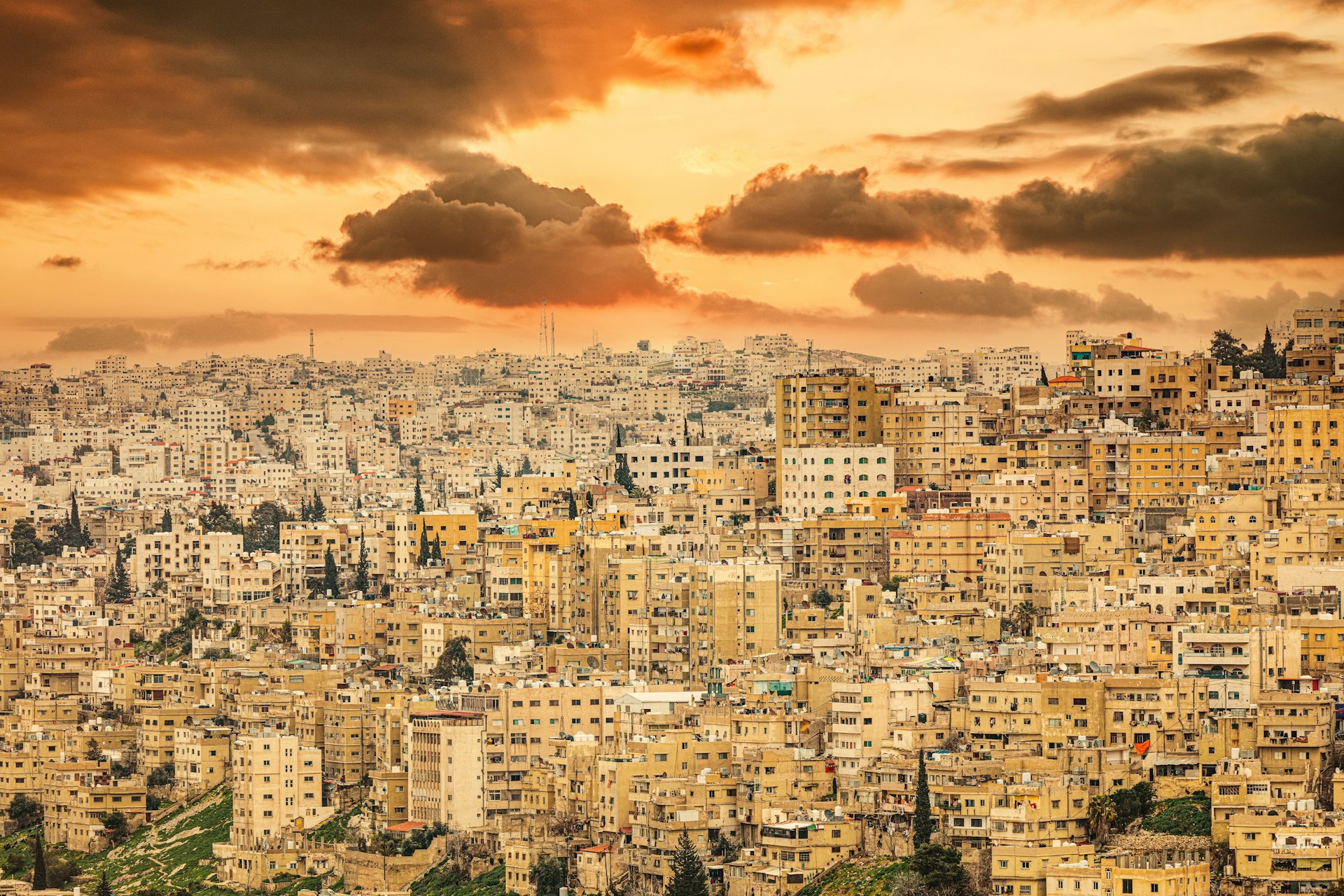
Best place for urban adventures
Don’t make the mistake of just passing through the capital city. Amman is well worth getting to know. More than just a gateway to the country, it’s Jordan’s heartbeat, pulsing with the energy of the old and new, and millennia of history and culture.
If you only have one day in Amman, you’ve got to go straight to the top. Visit the highest hill in the city to find the Citadel , an archaeological site that includes Umayyad Palace and the remaining pillars of the Temple of Hercules. Enjoy 360-degree views and respite from the cars and crowds below.
What goes up must come down – and when you do descend, make a stop at the Roman Theater before wandering Al Balad, the buzzing downtown district where you’ll find souvenir shops, street souks, argileh (shisha) cafes and vendors serving up fresh falafel and kunafeh (a Middle Eastern cheese pastry topped with nuts and syrup). Take a stroll on Rainbow Street before ending the evening on a high note with a sunset dinner at one of the city’s rooftop bars or restaurants.
If you have two days in Amman, learn more about the country’s history at the Jordan Museum or dive into Jordanian culture hands first with an interactive class such as a cooking lesson at female-run Beit Sitti or an olive-oil-soap-making workshop at Mosaic House .
Best place for ancient Christian sites
Just 20 minutes from Queen Alia International Airport, Madaba is a convenient and quiet place to rest your head on arrival in Jordan. A friendly and welcoming town for visitors of all faiths, Madaba is home to one of the largest Christian communities in Jordan.
You’ll find several churches in town; visit St George’s Church to admire one of the oldest known maps of the Holy Land, made of mosaic tiles in 560 CE.
Planning tip: While in the region, save time for a visit to Mt Nebo , just 15 minutes from Madaba. It’s believed Moses saw the Promised Land from the mountain’s summit – a view you can take in, too. Atop the mountain, some of Jordan’s most prized mosaics can be seen at Moses Memorial Church, while a small on-site museum highlights the place’s history.
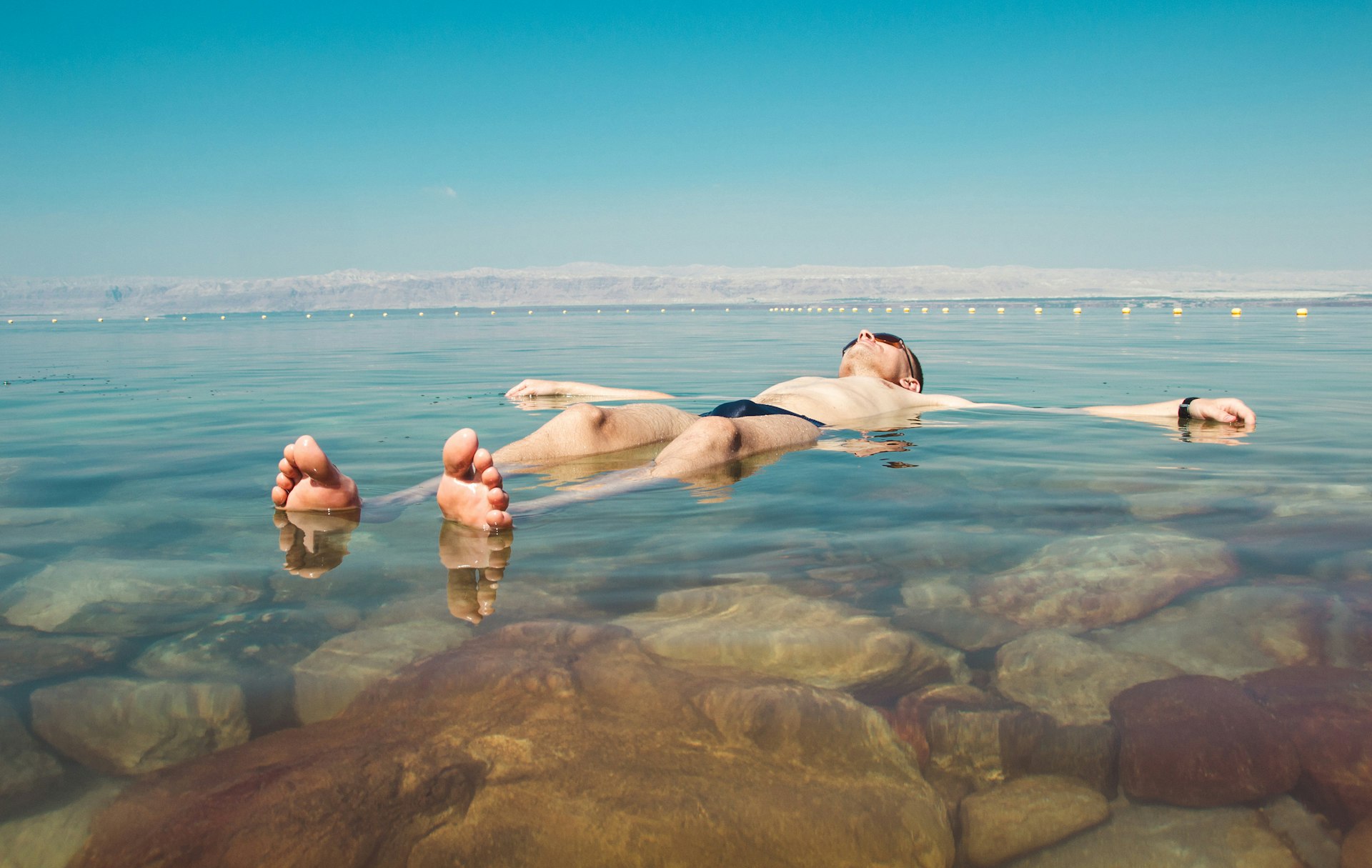
6. The Dead Sea
Best place for natural healing
Soak and scrub your worries away with a spa experience on the Jordanian shores of the Dead Sea. DIY types can wade in and slather on some mineral-rich mud before floating in the high-salinity water, while beauty mavens can continue the experience at a spa at one of the numerous luxury hotels by the shore (we love the treatments at the Kempinski Hotel Ishtar ).
In addition to the healing properties of the mineral-filled mud and water, the oxygen-rich air and dry climate of this region are also believed to be beneficial for people with a variety of health conditions. Just keep in mind the heat can be unbearable during the summer.
Planning tip: In the warmer months, consider an outdoor jaunt in nearby Wadi Mujib – the “Grand Canyon of Jordan” – with a hike in the shade of the gorge followed by a cool dip in the fresh water. You can also hike in the wadis (valleys) near South Ghor on the southern end of the Dead Sea with Al Numeira Environmental Association , then refuel at the organization’s cafe, which serves food and drinks made from locally sourced ingredients.
Best place for cultural icons
However long you're in Jordan, UNESCO-listed Petra is somewhere you shouldn't miss. The “Rose Red City,” so named for the pink stone and sand found here, is massive at 264 sq km (102 sq miles). You could easily spend hours, a full day or several days trekking the area and marveling at the handiwork and history of the ancient Nabatean culture.
Choose your own adventure depending on your interests, time and ability. If you’re short on time, take the road most traveled and hike through the Siq to reach the Treasury facade. (Yes, Jordan’s most famous site is the carved-stone setting you may have seen in the 1989 movie Indiana Jones and the Last Crusade .)
If you’ve got a full day, map out your can’t-misses in advance. If you have multiple days set aside and want to go beyond the most common sites, book a guided tour that might include storytelling, hiking, Arabic coffee and meals.
Local tip: Want to see Petra from another angle? Take a tip from Mohammed Ziad Abdullatif and hike to Petra (either from Little Petra or, if you’re up for a more challenging trek, via the multi-day Dana-to-Petra leg of the Jordan Trail) before exploring the ancient city. “The Petra Back Trail from Little Petra to Petra is my all-time favorite hike for its location, scenery, history and that first glimpse of the Monastery when it starts to appear,” Abdullatif says.

8. Wadi Rum
Best place for stunning desert landscapes
No spaceship is required to visit the Mars-like landscapes of Wadi Rum ; modes of transport here instead range from foot and camel to 4WD and even hot-air balloon. Rugged mountains and graceful natural arches in a sea of rust-colored sand make this protected area one of the most photogenic and beautiful places in Jordan – and the world.
Many travelers come seeking a slower pace and silence, though Wadi Rum has become so popular that you may have to go farther afield, away from the main sites and camps, to find true desert tranquility. You can also spend a day with a Bedouin guide hiking, cooking and learning how to build a tent.
One of the best places in the world for rock climbing, Wadi Rum also attracts active and adventurous travelers. Book a guided climb and overnight camping with Bedouin Campsite and Tours and learn from Bedouin people who’ve grown up scaling these sandstone giants.
Planning tip: The Red Sea resort city of Aqaba is an hour’s drive away and the perfect place for an indulgent spa treatment and a luxury stay after working up a sweat in Wadi Rum.
This article was first published March 2022 and updated November 2023
Explore related stories

Wildlife & Nature
Feb 27, 2024 • 6 min read
April is the ideal time of year for mild-weather hikes, cherry blossom festivals, fresh produce and more.

Jan 17, 2024 • 8 min read
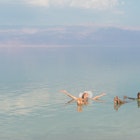
Dec 6, 2023 • 4 min read

Dec 4, 2023 • 9 min read
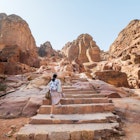
Nov 30, 2023 • 7 min read

Nov 29, 2023 • 4 min read

Jun 23, 2022 • 6 min read

Dec 23, 2021 • 5 min read
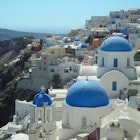
Jul 30, 2020 • 9 min read

Oct 28, 2019 • 19 min read

11 Top-Rated Tourist Attractions in Jordan
Written by Joni Sweet Updated Mar 19, 2024
Jordan is a traveler's dream introduction to the Middle East. Safe and friendly, the destination gets travelers up close to world wonders and immerses them in world-class hospitality . You'll feel right at home once you slip into the culture of this easygoing country.
UNESCO World Heritage Sites abound in Jordan. Marvel at fading frescos in the 1,300-year-old desert castle of Quseir Amra . Climb red sand dunes and stand in the shadows of weathered sandstone in Wadi Rum 's humbling desert landscape . And plan to spend at least two days exploring Jordan's crown jewel attraction: Petra . The jaw-dropping sites in the ancient Nabatean city will leave you stunned – and eager to see more.
But Jordan's not solely rooted in the past. Its hilly capital, Amman , brims with bustling restaurants and cafés, swanky shopping, and impressive art galleries. Then, there's the Dead Sea – where you can kick up your feet after days of sightseeing and dig in to some much-needed pampering at the many luxe waterfront resorts.
Plan your vacation to the Middle East and see the best places to visit with our list of the top tourist attractions in Jordan.
2. Dead Sea
3. wadi rum, 4. jerash ruins, 6. roman ruins in amman, 7. ancient mosaics of madaba, 8. wadi mujib, 9. desert castles, 11. mount nebo, map of tourist attractions in jordan, best time of year to visit jordan.
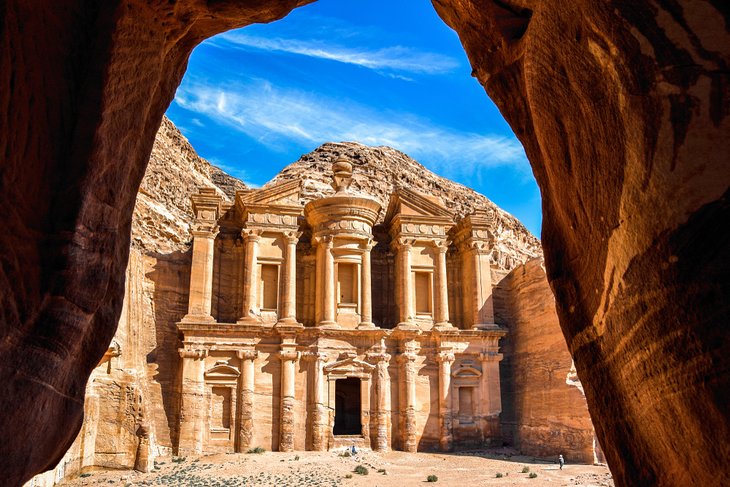
Prepare to be amazed by Petra. One of the New7Wonders of the World , this attraction has wowed modern-day visitors since the long-lost city's rediscovery by Swiss explorer Jean Louis Burckhardt more than 200 years ago.
You'll need at least two days to hit all the highlights around Petra, which include more than 800 registered sites . But if you have more time, you won't be disappointed spending it here. Wandering around a city this ancient in such a well-preserved state is an experience like none other.
Petra wastes no time impressing tourists. Immediately after the entrance, you'll see mysterious Djinn Blocks , imposing stone monuments whose original purpose still remains unknown, followed by the Obelisk Tomb. It's just a sample of the incredible sites to come.
From here, you'll make your way through the Siq – the famous snaking canyon pathway flanked by tall walls. Look along the walls to see the remnants of historic channels that were used to supply Petra with water, as well as niches for sacred carvings known as baetyls . These artifacts hint that Petra may have been considered a holy city at one point in time. Keep your eye out for the weathered relief sculpture of camels being lead by two merchants, as well.
Finally, you'll reach the unmistakable Treasury (also known as Al-Khazneh). Showcased in nearly every travel guide book and social media post about Petra, this attraction's Hellenistic facade is one of the most enchanting places to visit in Jordan. Legend has it that the rock-hewn monument, which was built as the final resting place for Nabatean King Aretas IV, was the hiding place for an Egyptian pharaoh's treasure at the time of Moses.
When it comes to things to do in Petra after the Siq and the Treasury, it's a choose-your-own adventure. Check out dozens of tombs and houses on the Street of Facades , climb steep stairs for a great view at the High Place of Sacrifice, stand in awe at the Theater and stroll down the impressive Colonnaded Street.
If your feet aren't too sore yet, make your way up the roughly 850 rock-cut steps to the legendary Monastery. The impressive structure, tucked in the hills, is well worth the journey.
If you thought Petra was incredible during the day, wait until you see it after dark. Reserve tickets to the Petra By Night show to see the Siq and the Treasury lit by more than 1,500 flickering candles.
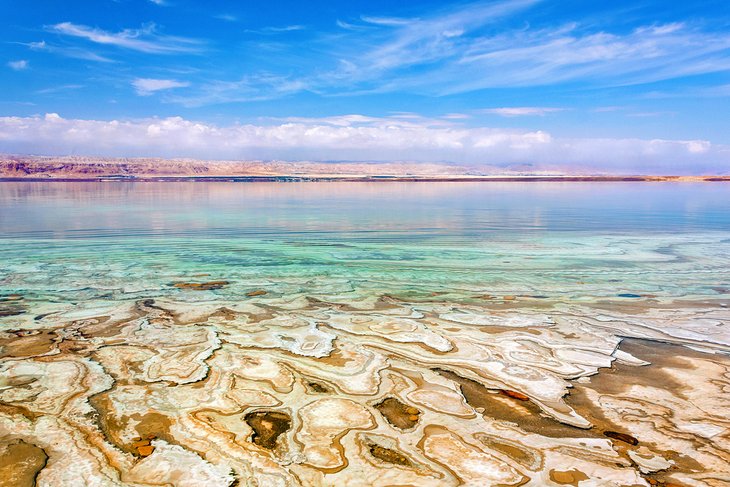
Floating in the Dead Sea is a quintessential thing to do in Jordan. The lowest point on Earth accessible by road, this body of water is located at 418 meters below sea level. It practically glows an intense shade of aquamarine – a particularly striking sight next to salt-encrusted rock ledges and barren red mountains in the background. You can reach the attractions in the Dead Sea region in about an hour by car from Amman.
The Dead Sea is renowned for its mineral-rich water. Wellness devotees believe the water has healing properties for the skin. Don't plan to swim laps, though – the Dead Sea is so dense and salient that all you can really do is float atop the surface.
You can access the Dead Sea from a couple of entry points, including Amman Beach. Better yet, splurge on a stay at one of the plush spa resorts on the Dead Sea's northeast coast. They typically have private wading areas complete with buckets of Dead Sea mud. One bath with this red-brown sludge, and your skin will be softer than ever.
Hot tip: Avoid getting Dead Sea water in your eyes at all costs. The intense salinity (10 times saltier than the ocean!) stings worse than you can imagine.
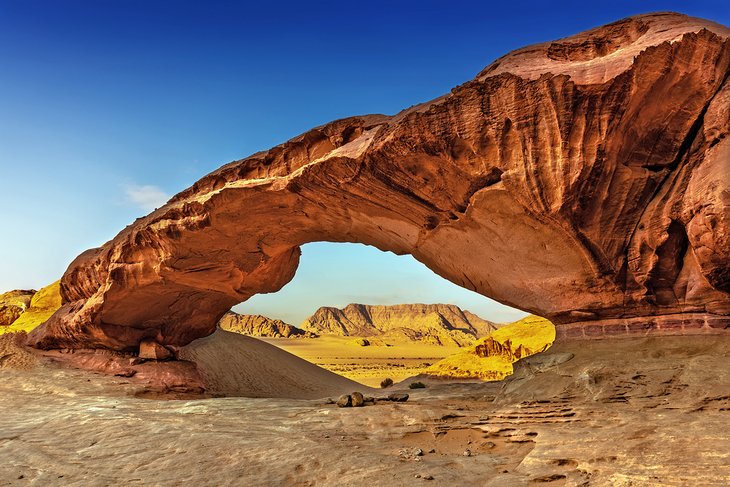
Head to the southern region of Jordan, and you'll be treated to one of the most spectacular landscapes across the globe: Wadi Rum. Also known as the Valley of the Moon, this sandstone and granite rock valley is an otherworldly experience, with towering cliffs, massive dunes, swirling archways, and caverns. It served as the set for much of the 1962 film Lawrence of Arabia and was tagged a UNESCO World Heritage Site in 2011.
Adventure lovers, eat your heart out: The Zalabia Bedouin, a cultural group that lives in the area, have transformed the Wadi Rum into an ecotourism playground. You can ride camels or spirited Arabian horses through the area, strap on a harness and go rock climbing up the sandstone mountains, hike through canyons , and kick up sand on ATV tours .
Ask your tour guide to take you to the Khazali Canyon , where you can see petroglyphs of humans and antelopes that may date as far back as the 8th century BC.
Consider spending the night at one of the luxurious " glamping " (glamorous camping) sites in Wadi Rum. With almost zero light pollution, the park offers incredible stargazing opportunities . No wonder visiting Wadi Rum is one of the top things to do in Jordan.
Official site: http://wadirum.jo/
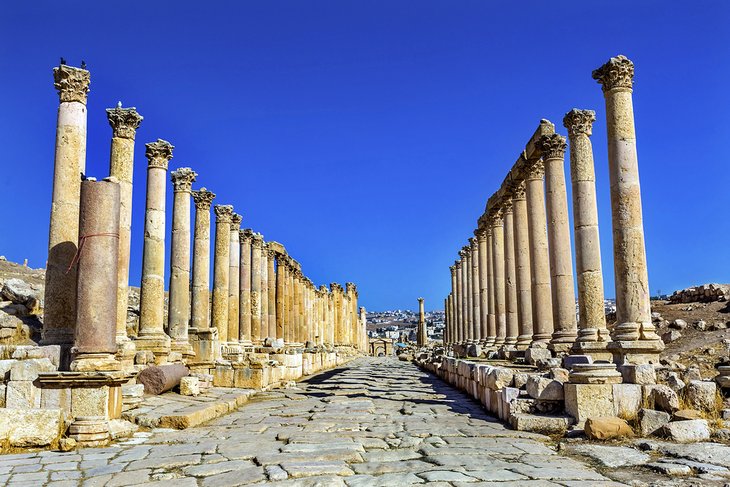
Nothing feels more like traveling back in time than visiting the Jerash ruins. It's one of the world's best-preserved ancient Roman cities and features spectacular places to visit, from colonnaded avenues and temples to a massive sports arena that once had a seating capacity of 15,000 spectators.
Tourists kick off their sightseeing adventure of the Jerash ruins by walking through Hadrian's Arch . The roughly 11-meter-tall structure is magnificent, but even more impressive when you consider it was originally double the size.
If that wasn't enough to wow you, wait until you explore what's ahead. The Hippodrome , a sports field constructed around the 2nd century, once hosted chariot races as entertainment for thousands of onlookers. The ancient sport is brought back to life through daily re-enactments, featuring fighting gladiators and chariots racing laps.
Another highlight of the Jerash ruins is the Forum. The oval-shaped plaza is lined by still-standing columns that give the space a regal feel. Climb the steps of the nearby Temple of Zeus to get an even better view of the colonnaded site. And imagine the performances that took place on the ornate stage of the South Theater . Jerash seems to have a fascinating ruin for everyone – explore to see which site is your favorite.
Hot tip: There's almost no shade in this archeological site. Bring plenty of water, sunscreen, and a sunhat to keep yourself protected from the harsh rays.
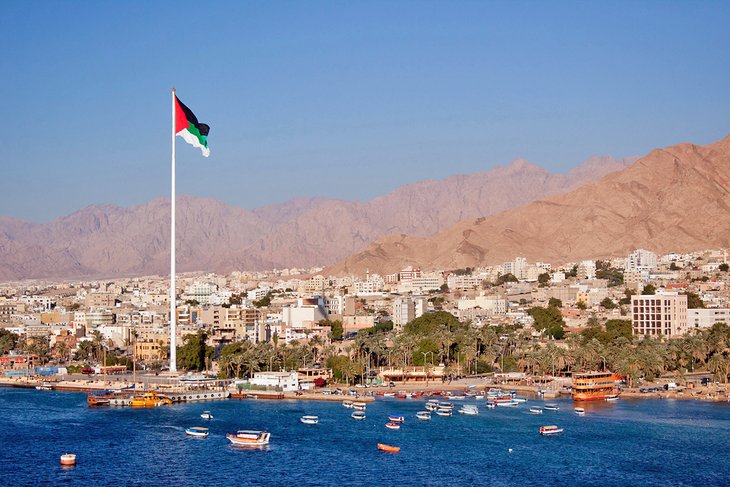
Think you can't have a seaside vacation in the hot, dry Middle East? Think again. Aqaba, a beach town on the southern tip of Jordan, treats tourists to holidays on the breathtaking coastline of the Red Sea .
Float, swim, snorkel, or dive – you can do it all from Aqaba. You can also get out on the turquoise water on one of the daily cruises offered by local hotels. Enhance your beach vacation in Jordan with a soak in one of the lovely hammams around the resort town.
When you're feeling peckish, dig into the local specialty of Aqaba: sayadieh , a dish of fish on flavorful rice with onion, tomato, and chili pepper.
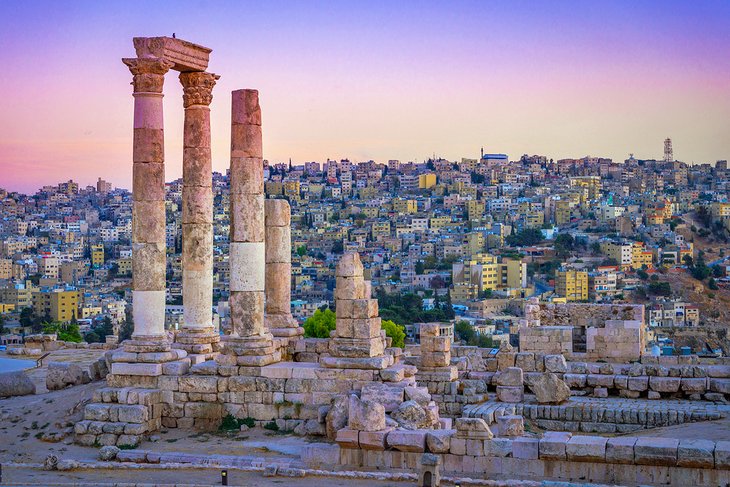
You don't have to go all the way to Petra to see fantastic archeological sites in Jordan. In fact, the capital Amman (where you'll probably arrive from abroad) is home to a variety of fascinating ruins, many of which are within short walking distance from one another.
Head downtown to see one of the most celebrated ruins: the Amman Citadel. Archeologists have found artifacts around the Citadel that suggest it has been occupied since at least the Bronze Age. Here, you can see the few columns that remain of the amazing Temple of Hercules , a significant Roman structure that was never completed. Look for the stone sculpture of several fingers, which were once part of a Hercules statue that may have been more than 12 meters tall. It hints at just how majestic this attraction was during its height.
One of the top attractions in Amman for history buffs is the Roman Theater. The restored amphitheater, which seats 6,000 people, dates back to when Amman was a Roman-ruled city known as Philadelphia, nearly 2,000 years ago. The attraction is still full of life, hosting many events and welcoming locals and tourists alike.
Nearby, tourists can visit the Nymphaeum , a Roman fountain that was built around the same time as the theater, as well as the smaller 500-seat theater, the Odeon.
After getting your fill of the ruins, see the vibrant culture of modern-day Amman with a sightseeing trip along Rainbow Street. The popular promenade boasts atmospheric cafés, fantastic people-watching opportunities, and souvenir shops galore!
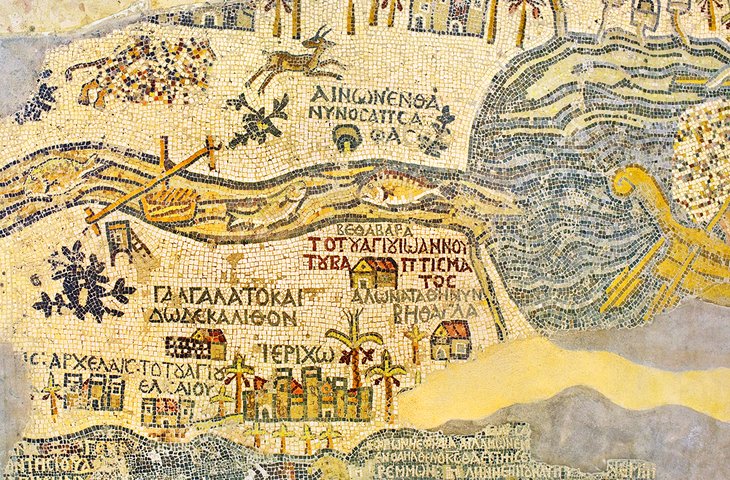
While sightseeing in many destinations demands you look up, the opposite is true in the historic trading city of Madaba. The city is home to the "largest number of mosaics discovered in their original location in the world," many of which are located on the floors of churches and buildings around the city.
The relatively unassuming St. George's Church is home to one of the most noteworthy mosaics in Jordan: the Madaba Mosaic Map. The 6th-century map depicts the Holy Land during the Byzantine period, showcasing Biblical-era cartography. While some of the original two million tiles are missing, the remnants of the map still give you an excellent glimpse at what the Middle East looked like many centuries ago.
Visitors can see more mosaics at Madaba's two archeological parks. The open-air museum at Archaeological Park I contains a stunning geometric mosaic from the Church of the Virgin Mary – a site from the 6th century that was unearthed in someone's basement in 1887. This attraction also houses the oldest mosaic in Jordan , which dates back to the 1st century BC, as well as breathtaking carpet-like tile work of the four seasons and nature that was once in a Byzantine villa.
Tourists can see other impressive mosaics at Archaeological Park II, located in the ruins of a luxurious mansion from the early 6th century.
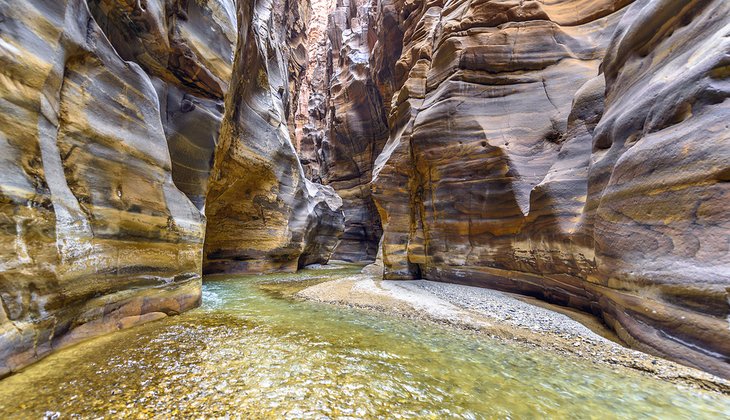
Stretching from the Desert Highway around 70 kilometers to the Dead Sea , Wadi Mujib is Jordan's answer to America's Grand Canyon. The river canyon, which is four kilometers wide and one kilometer deep, offers nature lovers the chance to explore unique scenery and see a plethora of wildlife, including Egyptian vultures, Nubian ibex, striped hyena, and the Syrian wolf.
There's great hiking through the Wadi Mujib gorge , if you don't mind getting a little wet. You can also head to the Mujib Reserve Biosphere to soak in picturesque hot springs just an hour and a half away from Amman.
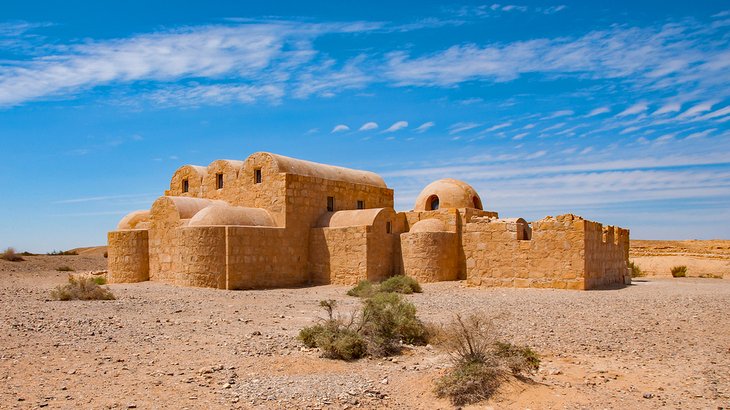
Stretching from Amman to the border of Saudi Arabia, the Zarqa Governorate is home to a series of archeological sites known as the Desert Castles. These early Islamic buildings were erected by the Umayyads around the turn of the 7th century. Not quite castles in the traditional sense, the collection of structures consists of hunting lodges, forts, military citadels, bathhouses, and rest stops for caravans, among other types of buildings.
Rent a car and drive the Desert Castle Loop to visit the sites. You'll get the chance to see Quseir Amra , a squat building with interiors covered with beautiful frescoes; Quseir Hallabat , a Roman fort that features volcanic basalt rock and a well-preserved mosaic; Quseir Al-Kharanah, a castle-like structure that has dozens of rooms, but whose original function has been lost to history; and Azraq Castle , an ancient walled fort known as the place where T.E. Lawrence sought shelter in 1917-1918.
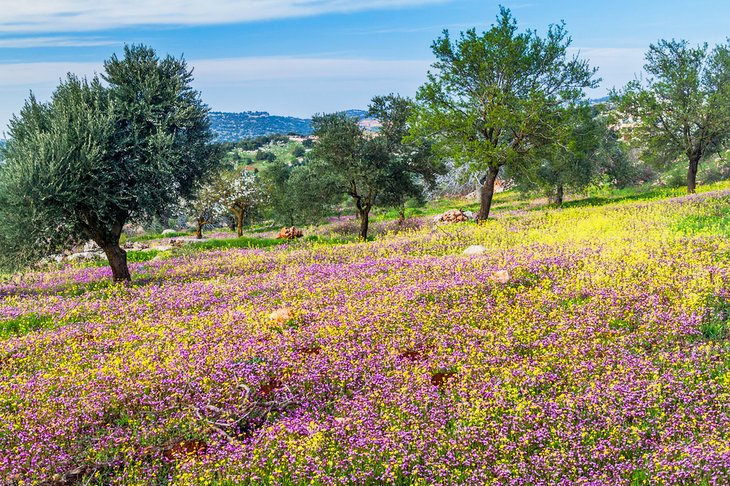
Situated just 20 kilometers northwest of Jerash , Ajloun makes a worthwhile trip for tourists who want to see some of the best natural scenery in all of Jordan. Plan to spend a day hiking around the Ajloun Forest Reserve , a 13-square-kilometer expanse of pristine, open woodlands. In the spring, the area is blanketed by wildflowers, which makes for spectacular photo opportunities. Keep your eyes peeled for the crested porcupines and striped hyenas that live in the area.
Be sure to visit the Ajloun Castle on the summit of Mount Auf. It was built in the 12th century in the footprints of an even older Byzantine monastery to protect against the Crusader attacks. Its mountaintop location offers sweeping views of the Jordan Valley.
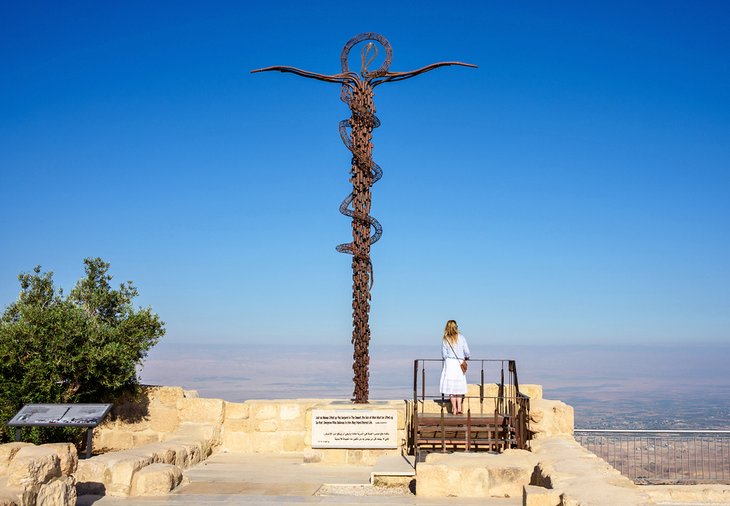
Mount Nebo is the crown jewel of Biblical sites in Jordan. According to the Old Testament, this mountain is said to be the place where Moses saw the Promised Land ahead of his death. Today, it's a spiritual attraction, with some of the country's best preserved mosaics from the 6th century, a Serpentine Cross , and the famous Moses Memorial Church.
Your ticket to the church includes access to Memorial Viewpoint, which has a small museum and views of the Dead Sea and Jerusalem on a clear day. But for more privacy with similar vistas, take a 100-meter walk on the road downhill from Mount Nebo and make a left toward the hilltop. It's the perfect spot for a picnic lunch.
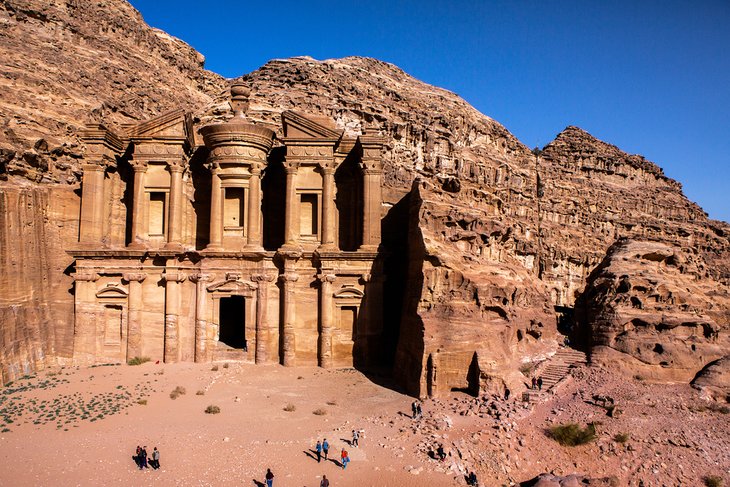
The best time to visit Jordan is from March through June , during the country's beautiful spring season. It's considered high season in the destination, as throngs of tourists flock to Amman, Petra, and the Dead Sea to take advantage of spring's warm days and breezy nights.
The weather and climate of Jordan can vary considerably depending on where you are. In Amman , towards the north, tourists can expect perfect weather for sightseeing in the spring . It's still a bit chilly in March, with low temperatures in Amman dropping to an average of six degrees Celsius and highs typically hitting 17 degrees Celsius. Bring a light jacket if you plan to go sightseeing at Amman's incredible archeological attractions, like the Amman Citadel and the Roman Theater.
The relatively temperate spring weather makes it a great time of year for tourists to tackle parts of the Jordan Trail. The long-distance hiking trail stretches from Umm Qais to Aqaba for a whopping 675 kilometers. Hikers can trek through some 75 villages and towns on the trail, experience some of the country's best desert sightseeing, explore ancient ruins, and make stops at major attractions (including Petra ). While the entire trail takes about 40 days to hike, you can tackle certain segments over the course of a few days.
The capital warms up throughout the spring, and by June, the temperature in Amman ranges from 17 degrees Celsius at night to 30 degrees Celsius during the day. While you might get the occasional shower in March or April, it hardly rains in Amman from May through October . Take advantage of the sunshine to explore Rainbow Street and enjoy the city's lovely al fresco falafel joints.
Jordan also has another sightseeing highlight during the spring season: flowers. Head to the northern hills to see the Earth carpeted by brightly colored w ildflowers, and drive along the King's Highway for a glimpse of Jordan's national flower, the Black Iris, blooming along the roadside. Who knew the landscape of the Middle East could be this vibrant?
The best time to visit Jordan's biggest attraction – Petra – is also in the spring . It's typically a couple of degrees warmer than Amman. While the cool early spring temperatures make sightseeing in Petra more pleasant in Mach and April, tourists can enjoy 14 hours of daylight in June. The extra light gives you lots of time to venture beyond the Siq and Treasury and see some of Petra's other interesting attractions, like the Colonnaded Street and the High Place of Sacrifice. Ambitious (and fast-walking) tourists may even have time to climb the 850 rock-cut steps to reach the Monastery , one of Petra's most impressive structures, before the sun sets.
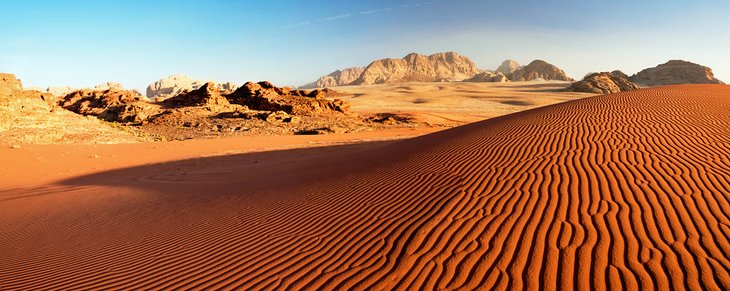
If you want to camp out in Wadi Rum , or simply enjoy the Valley of the Moon's amazing scenery and ancient petroglyphs on a day trip, plan to visit in early spring. The temperatures in March and April range from lows of 8 degrees Celsius to highs of 29 degrees Celsius . If you had to pick between the two months to visit Wadi Rum, go for May – it has a lower chance of precipitation that might otherwise rain out your adventures.
However, if you're drawn to the Red Sea and the beach town of Aqaba, you may want to visit earlier in the season, such as March or the beginning of April. You can expect temperatures to range from 14 to 18 degrees Celsius on the low end to highs of 27 to 31 degrees Celsius during this time of year.
By May, southern Jordan heats up to scorching temperatures – highs climb to an average of 36 degrees Celsius that month, and it regularly hits 40 degrees Celsius by July and August. It rarely rains in Aqaba, so if you visit in early spring, you can enjoy pristine beach weather and ample sunshine for snorkeling, swimming, and diving.
If you're in Jordan in early summer, you can experience one of the country's official public holidays, King Abdullah's Coronation Anniversary , on June 9. Events occur all over the country to commemorate the rise of the king and celebrate Jordan as a nation.


Touropia Travel Experts
Discover the World
12 Best Places to Visit in Jordan

The perfect introduction to the Middle East, Jordan has long been one of the region’s most popular countries to visit. While it is mostly known for the phenomenal ruins of Petra and the salty Dead Sea, there are plenty of other amazing things to experience. Aside from its ancient archaeological sites and epic desert landscapes, you can enjoy delicious local dishes and unforgettable Arab hospitality.
As it is located at the crossroads of Africa, Asia and Europe, the arid area east of the Jordan River has been ruled by countless civilisations over the millennia. Everyone from the Romans to the Umayyads and Ottomans left behind incredible old ruins. The most renowned of these is of course Petra. The country’s standout symbol, it was hewn out of solid rock by the Nabateans amidst rugged desert canyons.
Map of Places to Visit in Jordan
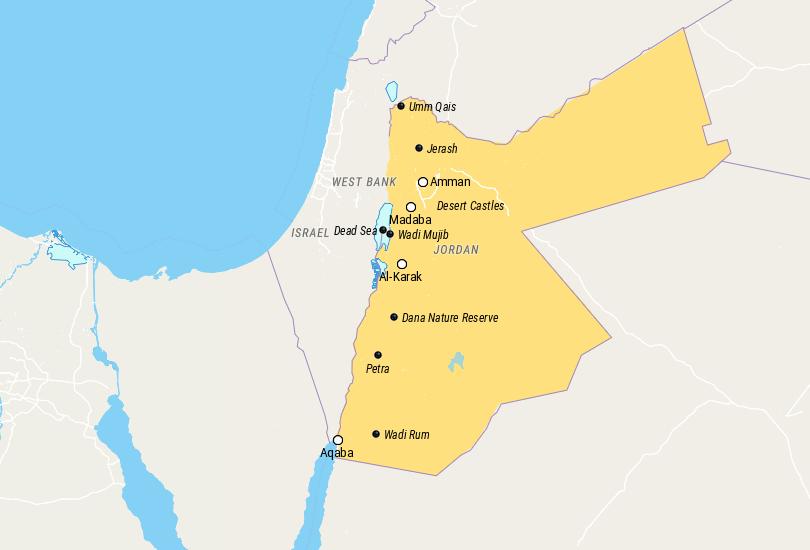
Now known as the Hashemite Kingdom of Jordan, it is certainly one of the safest and most stable countries in the Middle East. As such, it now houses a large population of Palestinian, Iraqi and Syrian refugees. Its capital Amman has also grown enormously over the last few decades due to this. A mix of old and new, it makes a peaceful base for visiting the nearby Desert Castles and the Dead Sea.
Whether it is relaxing by the Red Sea, admiring ancient Roman ruins or exploring its atmospheric souks, there are plenty of interesting places to visit in Jordan. Add in its magnificent Middle Eastern cuisine and friendly, welcoming people and you’ll come away instantly wanting to return again.
12. Umm Qais
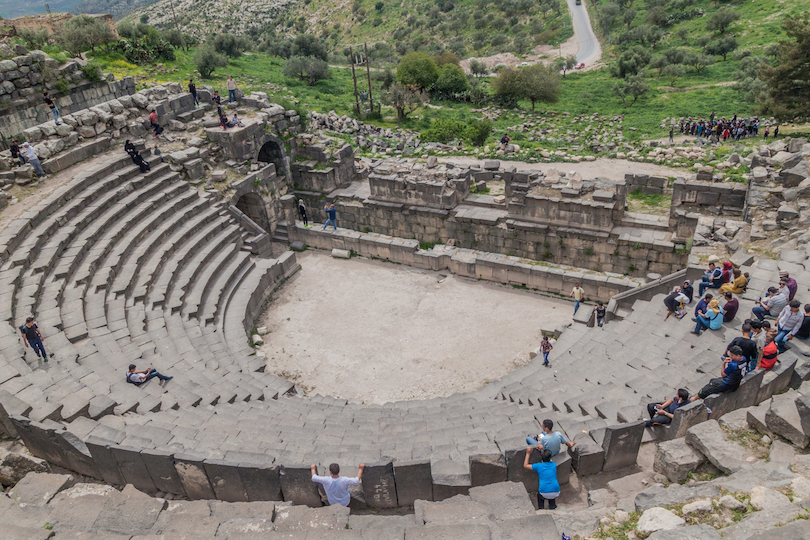
Nestled away right in the very north of Jordan are the impressive and extensive ruins of Umm Qais. Fascinating to explore, they can be reached in roughly two hours from the capital with many day trips departing here. The sprawling archaeological site also has an excellent museum and outstanding views over the surrounding area to enjoy.
Thought to have been founded as a military colony by Alexander the Great’s troops, Gadara, as it was then known, dates to around the third century BC. During the Hellenistic and Roman periods, it acted as an important centre of Greek culture in the region.
Now lying in ruin, it has ancient temples, houses and a collonaded street for visitors to wander around. The highlight though has to be its terrific theatre made out of black basalt which is in remarkably good condition. According to the Bible, Umm Qais is where Jesus cast demons from men to pigs.
Asides from seeing statues, masks and mosaics uncovered here in its museum, you can gaze over the Sea of Galilee and Golan Heights from its prominent hilltop setting.
11. Wadi Mujib
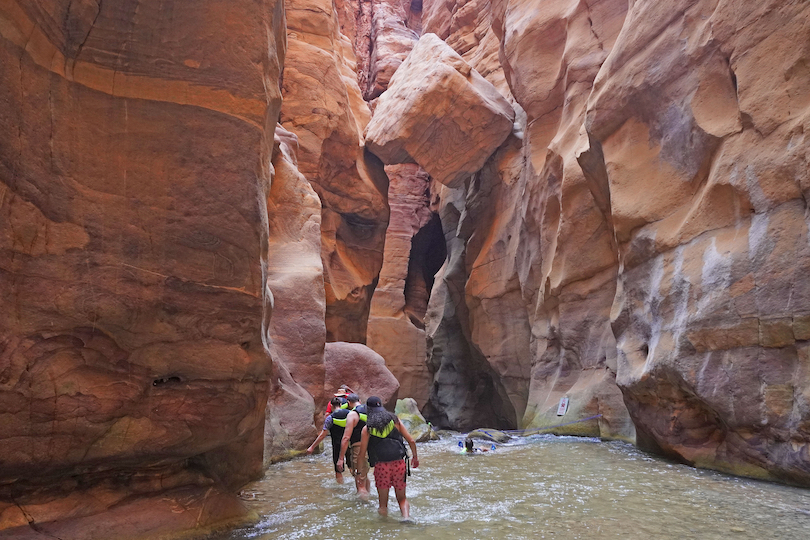
While Wadi Rum understandably attracts the most attention, Wadi Mujib’s landscapes are every bit as awe-inspiring. Known as ‘Jordan’s Grand Canyon’, the gigantic gorge runs from the Desert Highway right the way to the Dead Sea. Other than ogling at its immense size and scale, you can try all kinds of fun outdoor activities here and even go wildlife watching too.
An important boundary line since Biblical times, it stretches about seventy kilometres in length. Cutting its way through the desert, the canyon plunges over a thousand metres in depth at its lowest point. The King’s Highway winds its way through part of it while the enormous Al Mujib Dam controls the river’s flow.
In the Mujib Biosphere Reserve that protects its western side, there is an exhilarating rappel down to its rushing waters. Besides clambering about its dramatic formations, you can sometimes spot animals and birds amidst its vast wilderness. These include Nubian ibex, striped hyenas and Egyptian vultures. We absolutely loved stopping off and exploring its rugged confines on our way from Amman to the Dead Sea.
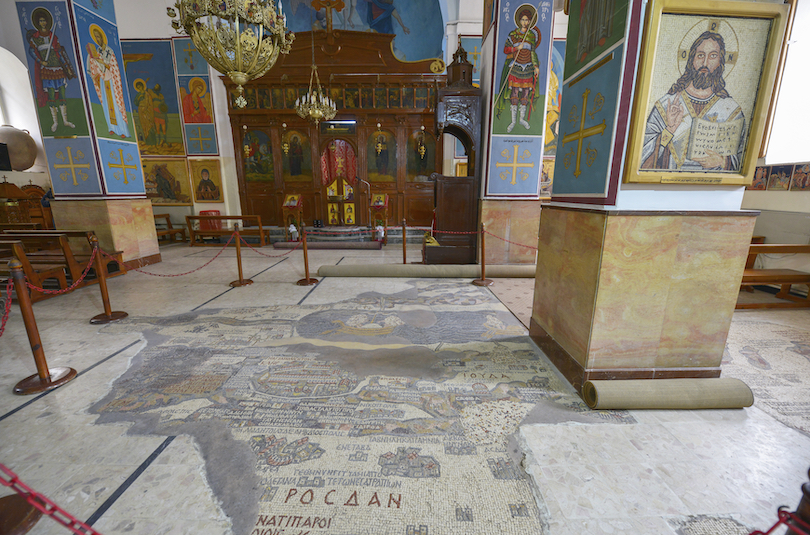
Also located alongside the King’s Highway in between Amman and Wadi Mujib is the ancient city of Madaba. Best known for its beautiful old Byzantine and Umayyad-era mosaics, its incredible archaeological parks are amazing to explore.
Scattered across the city, its millennia-old mosaics coat the floor of countless houses and churches. The most famous of these is certainly the sixth century ‘Madaba Map’ in the Basilica of Saint George. Its two million pieces of coloured stone impressively depict Jerusalem and the Holy Land in great detail.
After snapping pictures of this unique artwork, you can see more mosaics in its archaeological park and on-site museum. Other sights to amble around here are the ruins of Umm ar-Rasas, a former Roman military camp, and the atmospheric Church of the Apostles which dates to 578 CE.
Mount Nebo also lies just to the northwest and is often visited together with Madaba as part of day trips. Said to be the place where Moses gazed over the Promised Land just before his death, the mighty ridge offers up divine views over the Jordan Valley. A number of magnificent mosaics, the Moses Memorial Church and a Serpentine Cross can also be found here.
9. Dana Nature Reserve
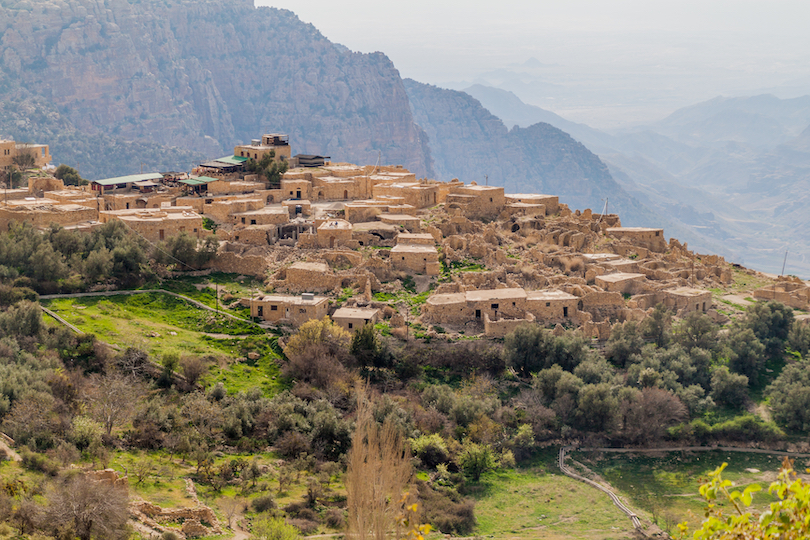
For those looking to see more of the country’s spellbinding landscapes and scenery, the Dana Nature Reserve is the perfect place to go. Amidst all its endless wilderness, you can hike for days and barely come across another soul. There is also a charming stone village and some comfy lodges to stay at, should you want to explore further.
Part of the Great Rift Valley which remarkably stretches to Africa, Jordan’s largest nature reserve encompasses four different bio-geographical zones. Alongside arid areas and sand dunes, you can see wind-cut sandstone cliffs scarring its soaring mountains. Plummeting gorges and fantastical rock formations only add to the drama of the scenery before you.
Crisscrossing its plateaus and valleys are plenty of picturesque paths for you to hike along. As you slowly make your way about the park you’ll spy Nubian ibex and Syrian serin amongst its sparse shrubs and hundreds of plant species.
Staying at the dilapidated Dana Village only completes the experience. Perched right at the edge of a steep cliff, its partially reconstructed houses have been around since Ottoman times. Its handful of hotels make a great base for exploring the region.
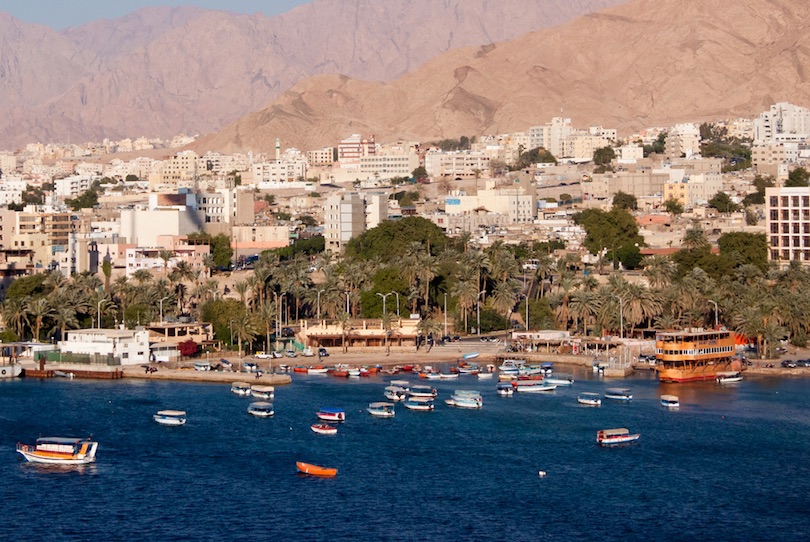
If instead of hardcore hiking, you want to swim, scuba dive or enjoy some other water sports, then Aqaba and its exciting adventure activities is a better bet. Lying along the Red Sea next to Eilat in Israel, the popular tourist destination also borders Egypt and Saudi Arabia.
Due to its strategic setting on the Gulf of Aqaba between Africa and Asia, it has been an important port for thousands of years. As such, some interesting historic sites also exist in town. These include the sixteenth century Aqaba Fort and the sparkling white Sheik Zayed Mosque. You can also marvel at the ruins of the ancient Aqaba Church. Considered the world’s first purpose-built Christian church, it dates to about 300 AD.
After the stifling heat of the desert, its twinkling turquoise waters offer some welcome respite. In addition to relaxing at top-class hotels, on the beach or being pampered at hammams, you can snorkel and scuba dive in the Red Sea. The coastal city also has sightseeing cruises to take above its all rich marine life and colourful coral reefs.
7. Al-Karak
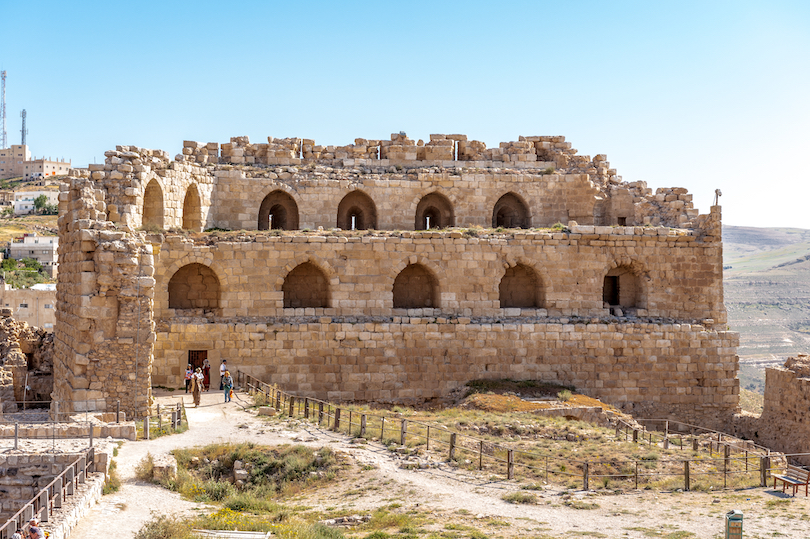
If you’re interested in castles, then Al-Karak is definitely worth a visit. The city of Al-Karak, also known as just Karak or Kerak, is located in Southern Jordan. It is known for its significant Christian population as well as its amazing castle. Al-Karak is home to the Citadel of Kerak, which was once a Crusader stronghold.
After being ransacked, the castle was left in ruins for nearly 500 years. Some restoration work has taken place, and you can tour the castle to see the parts that have been restored. In the lower portion of the castle is the Karak Archaeological Museum, which boasts an impressive collection that helps explain more about the region’s history.
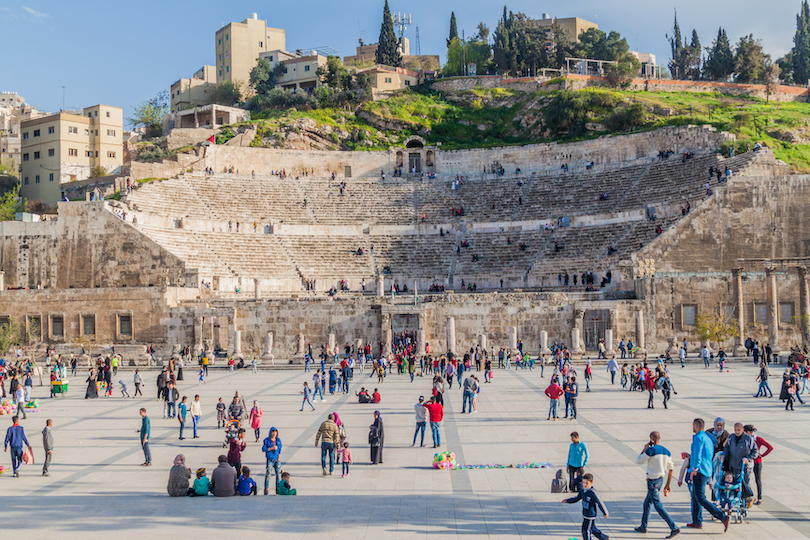
Often derided (unfairly we think) for being boring, Jordan’s capital Amman is a lovely city to spend a few days. For such a massive, modern metropolis, it has many calm, quiet neighborhoods with most of its main attractions lying within walking distance of one another.
One of the oldest continuously inhabited places on Earth, it has a number of ancient historic sites dotted about. Its crumbling citadel for instance was settled 12,000 years ago with Roman, Byzantine and Umayyad ruins still occupying its hilltop. From here, you can look out over the whole city stretching away before you. Down below is also a well-restored Roman theater to clamber about, cut into the side of another hill.
After seeing its two main sights, make your way to the nearby Rainbow Street for a radical change of scene. Rather than age-old ruins, the popular promenade has tons of trendy rooftop restaurants, streetside cafes and cool shops to check out. If you’re after even more shopping, then the more traditional Souk Mango is the place to go.
Unlike many other capitals in the Middle East, we found Amman surprisingly peaceful and relatively easy to get around. Its interesting history, excellent food and extensive shopping options made it the perfect base for seeing the rest of the country.
5. Desert Castles
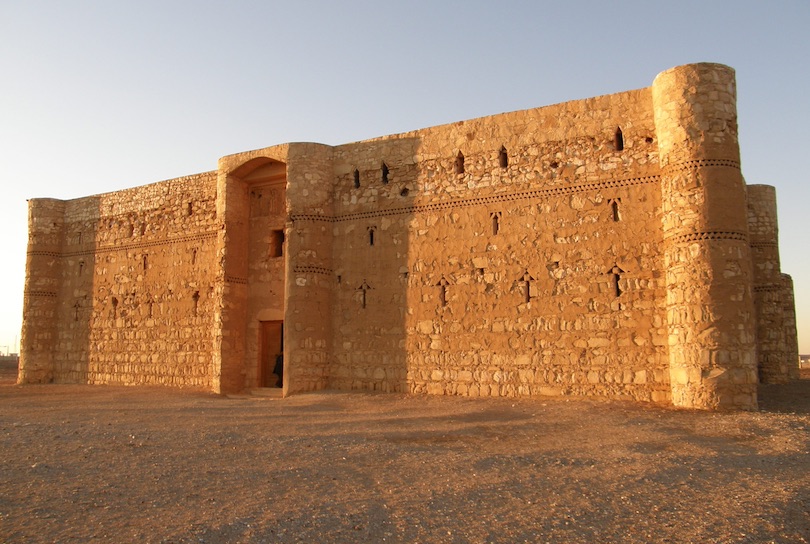
Scattered about the semi-arid regions of northeastern Jordan are numerous old forts and palaces known as the Desert Castles. Fascinating to explore, they usually lie in isolated spots, alongside oases and what were once important trading routes. If you rent a car or arrange a tour, you can easily visit quite a few in just a single day while driving along the Desert Castle Loop.
Erected by the Umayyads around the seventh century, the castles typically consist of a fortified complex, including a mosque, bathhouse and other buildings. Either used as hunting lodges or military outposts, the main residence was usually decorated with marvellous mosaics, frescoes and reliefs.
Particularly impressive are those of Qasr Amra and Qasr Hallabat as both showcase some beautiful frescoes and mosaics. The castle-like Qasr Harana is also well worth checking out as is Qasr Azraq. Aside from exhibiting some outstanding architecture, it was here in 1917-1918 that T.E. Lawrence based himself during the Arab Revolt.
4. Dead Sea
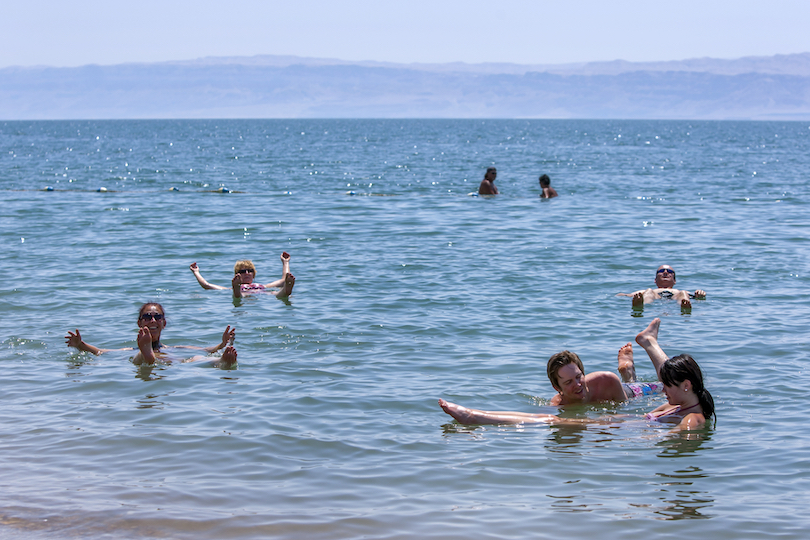
Although most of Jordan is landlocked, it does share one small piece of coast with the Dead Sea. The Dead Sea is the lowest point on the planet, 430 meters (1,400 feet) below sea level, and the salinity level is incredibly high. The Dead Sea also has a number of historic and religious ties, and it was the site where the Jesus was allegedly baptized by John the Baptist.
It is also an amazing place for relaxation, because the water is full of minerals and the high salinity makes it easy to float on your back. The best way to visit the Dead Sea is to stay at one of the luxury resorts at the northeastern end of the sea. Here you can enjoy a spa treatment, watch the sunset across the water and even see the night lights of Jerusalem.
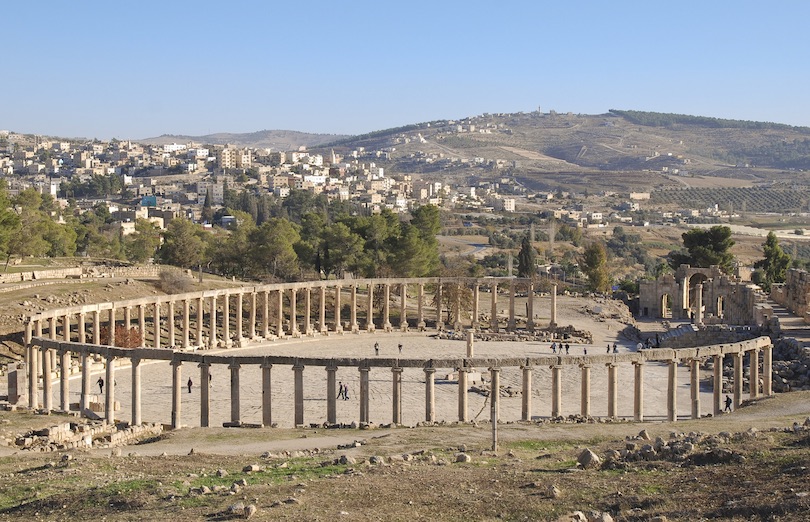
Even bigger and better preserved than those of Umm Qais are the remarkable ruins of Jerash. One of the most popular places to visit in Jordan, the almost endless archaeological site has countless temples, plazas, theaters and streets to stroll about. Lying in the north of the country, forty-five minutes from Amman, it really is a must for history lovers.
While the earliest ruins uncovered here date to 7,500 BC, the ancient city flourished from the 1st to the 7th centuries under the Romans. They constructed lots of massive monuments with Hadrian’s Arch and the Hippodrome being particularly astonishing to see. Other highlights include the colossal colonnades of its Forum and the stunning stage of the South Theatre.
To understand all that you’re seeing, it’s a good idea to go with a guide. We went with a local archaeologist who explained in great detail how the large city once functioned, as well as its rise, fall and ongoing excavations.
Even without any explanations though you’re guaranteed a lovely time as the Roman ruins are just so immense and extensive. Ambling about its Temple of Zeus and Oval Plaza while snapping photos of everything ended up being one of our favorite things we did in the country.
2. Wadi Rum
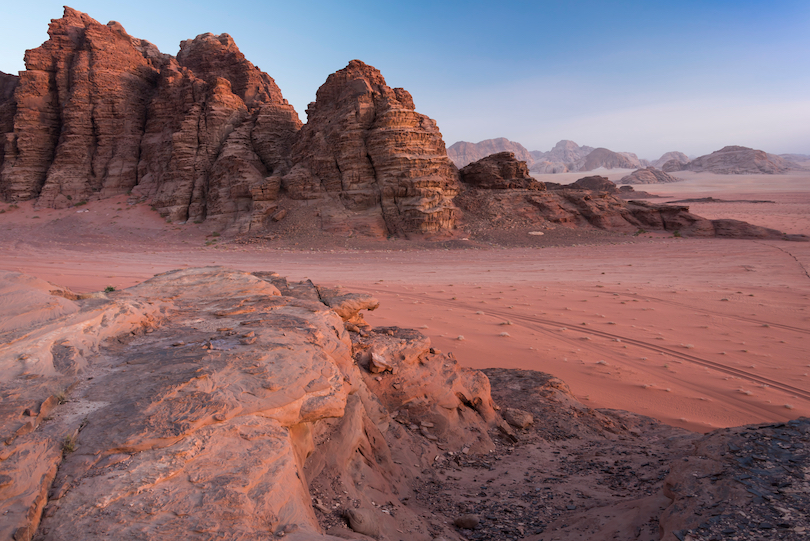
In Southern Jordan is Wadi Rum, a desert valley known for its breathtaking scenery. There are no permanent settlements in this secluded desert region, but Bedouins and nomadic tribes do occasionally pass through. Although deserts are often imagined as dunes, Wadi Rum boasts sandstone mountains and towering granite cliffs.
Many of the major attractions in Wadi Rum are natural landmarks and rock formations as well as unique colors of sand or rock. The Umm Fruth Rock Bridge, for instance, is truly remarkable to behold in person.
The distinctive reddish-orange colors that lend the area an otherworldly quality has brought severals science-fiction films here (such as The Martian) to replicate the Red Planet. Lawrence of Arabia also spent time in Wadi Rum, so you can tour places like his house and what is known as Lawrence’s Spring.
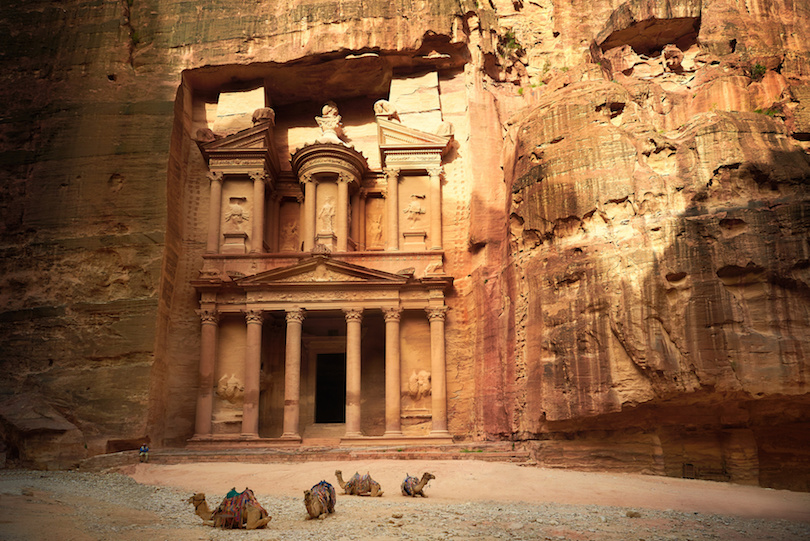
The best place to visit in Jordan, and now one of the new Seven Wonders of the World, is the ancient city of Petra. Also known as the Red City or the Rose City, Petra was once the capital of the Nabataean Kingdom before becoming part of the Roman Empire. The settlement was abandoned and forgotten for centuries by the Western world, but it was rediscovered in the 19th century.
Today, a visit to Petra allows you to tour the ancient archeological park, entering through the sandstone canyon known as Siq. After the Siq is the magnificent Treasury, which was actually not a treasury but probably a temple or a royal tomb.
Other significant ruins include the Roman Theater, The Monastery and the Street of Facades, a huge canyon bordered with the facades of assorted tombs. For the most spectacular views, hike to the Mountain of Aaron, which allows you to look down on Petra and its amazing rock-cut architecture.
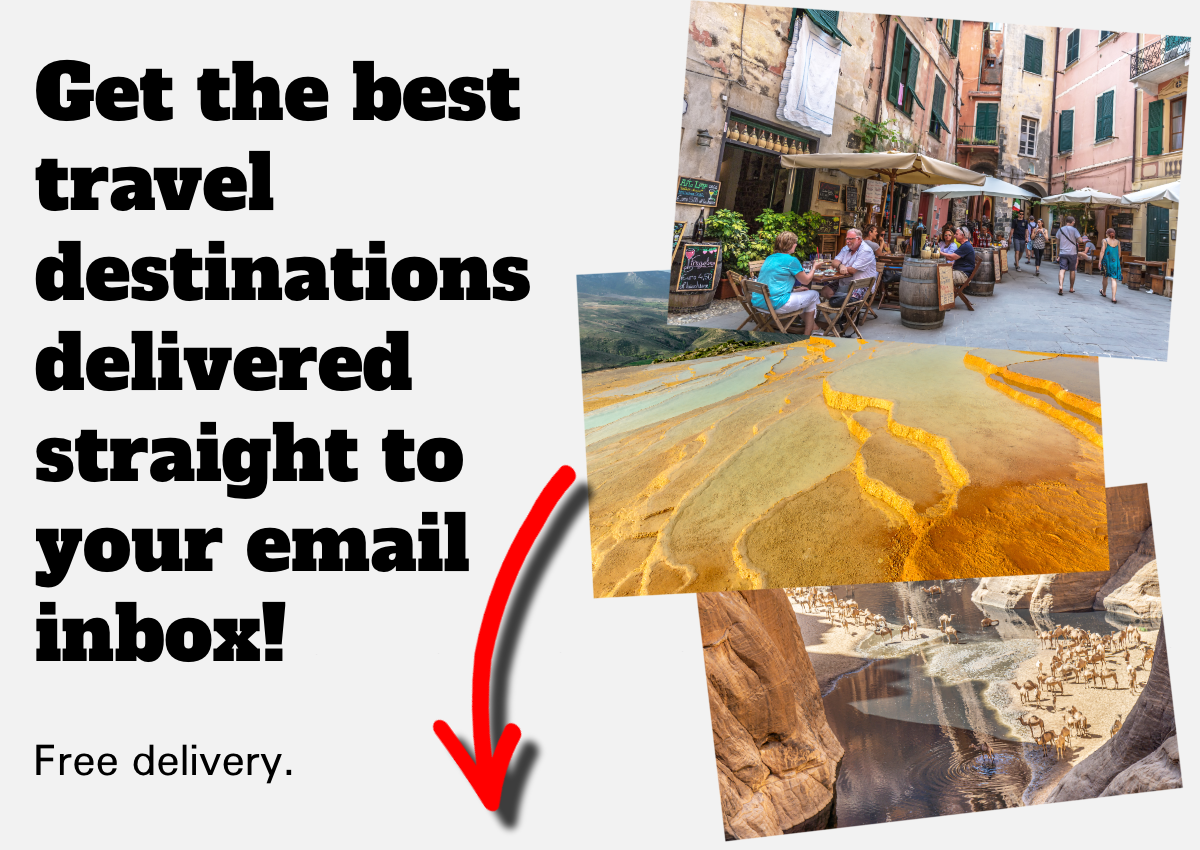
Share this post:

15 Best Countries to Visit in Asia
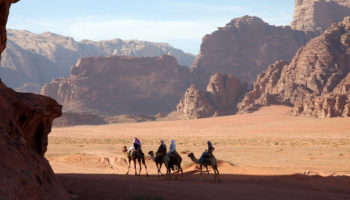

15 Best Things to Do in Jordan
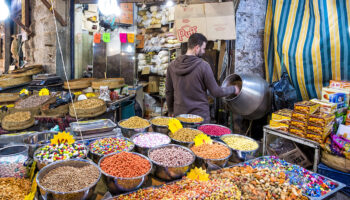
16 Best Things to do in Amman, Jordan
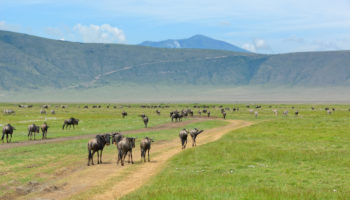
10 Best Countries to Visit in Africa

10 Best Seychelles Luxury Resorts
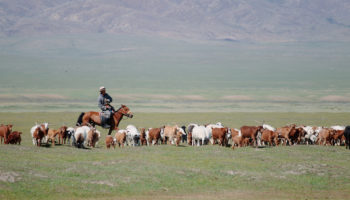
10 Best Places to Visit in Mongolia

12 Top Attractions & Things to do in Madagascar
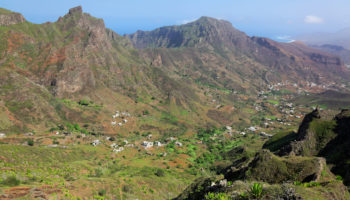
10 Best Cape Verde Islands

23 Most Beautiful Islands in Asia

Visit Meroë: The Mysterious Pyramids of Sudan
Reader interactions.
January 24, 2017 at 11:47 pm
The city of salt about 30 km north of Amman has a unique architecture , the buildings has about more than 20 style of doors windows and the allys also the allys captures the past beauty. It has a captivating mosque and churches. The mayor aiming at placing it as national and world city
Leave a Reply Cancel reply
Your email address will not be published. Required fields are marked *
This site uses Akismet to reduce spam. Learn how your comment data is processed .

Home » Travel Guides » Jordan » 15 Best Places to Visit in Jordan
15 Best Places to Visit in Jordan
Jordan occupies one great cut-out of the Arabian Peninsula. Sandwiched between the more tumultuous nations of contested Israel, Iraq and Syria, it’s long been considered one of the rare stable enclaves of the region; one replete with mind-blowing UNESCO World Heritage Sites and totemic cultural hotspots – not least of all the carved ancient Nabatean ruins of Petra and the very site where Jesus Christ is thought to have been baptized!
Add in a deep, deep history going back thousands of years to the times of the earliest humans (archeological findings have suggested that even Neanderthal roamed these parts), and Jordan also begins to reveal its crumbling Roman cities, its exquisite Ottoman charm, those Persian treasures and Egyptian relics from long gone dynasties.
Jordan isn’t all about touring the past though, and you’ll only have to look to the lively streets of Aqaba on the Red Sea for world-class diving, or the downtown areas of Amman – the capital – for a burgeoning nightlife scene and up-coming modern art to boot.
Lets explore the best places to visit in Jordan :

The undisputed piece de resistance of Jordan is a place totally unlike anywhere else in the country.
Set out between the red-hued desert escarpments in the southern heartlands of the country, it’s thought the site was first inhabited in the 4th century BC. It was the ancestral capital of the thriving Arabian Nabataean civilization, which managed to raise the rock-cut treasuries and temples here to one of the most important trading outposts in the region.
Today, the whole enchanting site is known for its roles in Hollywood blockbusters like Indiana Jones, and comes hidden between a series of winding siq (tunnels created by erosion) passageways that are a real treat to explore.
In short: Petra is not to be missed!
2. Al-Maghtas

Butting up to the Israel-Jordan border on the extreme eastern edge of the country, the dust-caked conglomeration of small dig sites and uncovered builds known as Al-Maghtas is arguably one of the most important biblical relics to be found on the entire courses of the Jordan River.
Tagged by UNESCO and slowly becoming a high-profile pilgrimage site for Christians (think papal visits aplenty in the last couple of decades), it’s thought to have been the original site of the baptism of Jesus.
Apart from that, the spot displays an interesting array of Jewish and Christian religious remains, Roman constructions, and Orthodox monasteries from the ages of the Ottomans and Mamluks.

Amman is a great place to feel the beating pulse of Arabia, and get a sense of the deep histories and cultural strands that inform Jordan as a whole.
Head to the warren of streets that weave and wind through the hectic center of the capital to see the mosaic of frenetic souks and echoing mosque minarets that make up the famous area of Balad.
Or, go to Abdali, where leafy boulevards give way to chic cafes and high-street boutiques.
There’s a clutch of must-see sights and landmarks to add to the menu too: that colossal Roman Theatre; the occasional remains of Ammonite fortifications; the medley of mosques and churches and palisades that make up the Jabal al-Qal’a citadel…

It’s a testimony to the sheer wealth of immersive history that still exists at the ruined city of Jerash that this site just north of Amman pulls in almost as many visitors as the legendary rock-cut temples at Petra.
Yep, this medley of towering colonnades and old forums, fascinating temples turned to Byzantine churches, and great plazas is hailed as perhaps the most amazing Roman provincial city still on the planet today.
You can come and stand where merchants from the Med would once have touted their goods, or imagine the hubbub of camel caravans arriving here straight from the dunes of the great Arabian sand sea.
5. Wadi Rum

Sun-scorched and glowing deep orange and red under the Arabian sun, the breathtaking reaches of the Wadi Rum of southern Jordan are surely one of the most awesome natural wonders in the region.
Carved from the rocky limestone escarpments that rise and fall dramatically on the eastern fringes of Aqaba, the famous valley is quintessential Jordanian backcountry.
Huge bluffs of rock-ribbed mountains loom on the horizon; mythic petroglyphs from ancient Nabatean peoples hide in the nooks and crannies; camels groan, and climbers swing tenuously from ropes around the hoodoos.
It’s hardly a surprise that this was chosen as the backdrop to one Lawrence of Arabia back in 1962!
6. Dead Sea

The Dead Sea carves its way through the heartlands of the Middle Eastern Levant.
The lowest and most salty of the world’s ocean water bodies, it’s encircled by rising mountains and ochre-hued sand dunes, all of which reflect majestically upon the surface as the Arabian sun beats down.
Today, the whole area on the Jordanian banks (the western side is over the border in Israel) comes dotted with beaches and resort hotels, while the south of the sea is taken over with interesting mineral evaporation pools, built for the harvesting of carnallite and potassium.
The favorite activity though? Well, that’s surely lazing on the surface of the water, where the high saline density keeps travelers afloat like logs!

Aqaba is Jordan’s gateway to the Red Sea.
It buts up to the out-and-out resort town of Eilat in Israel across the border, and crowns the tip of the salty water with a medley of palm-spotted promenades and yellow sand beaches.
Today, widespread redevelopment projects, and the raising of uber-luxurious resort hotels at Tala Bay just to the south, are converting Aqaba into the perfect seaside escape in the Middle East.
You can tour the ancient ruins of Tall Hujayrat Al-Ghuzlan, see the date trees of the Shatt Al-Ghandour, or do what most do: go underwater on a SCUBA excursion to see the multi-colored reefs that fringe the submarine beds all around.
8. Mujib Nature Reserve

This vast swathe of north-west Jordan promises some seriously breathtaking backcountry, complete with winding river valleys and dust-caked gorges, steep-sided valleys sculpted over the centuries and oodles of hidden walkways chiseled out of the rocks.
It’s known as the lowest nature reserve on the globe, and slopes down slowly to the saline waters of the Dead Sea.
Today, it’s taken over largely by adventure tourists and outdoors outfitters, who offer everything from intrepid hikes to heart-thumping rock climbing in the canyons to zip-lining through the dry and dusty air.
9. Dana Nature Reserve

Go back in time with a trip to the rugged lands of the Dana Nature Reserve.
This sweeping dash of carved valleys and rock-ribbed hills, scrub-dressed mountains and chiseled peaks topped with crumbling rocks, is not only Jordan’s largest protected area, but also offers a glimpse at the age-old lifestyles of the Middle Eastern folk who’ve made their home here.
You can bed down in drystone huts in the ancient villages, or opt to camp under the stars, all before days of hiking through the dusty canyons and spotting rare Nubian ibexes on the ridges.
It’s wonderful stuff for the outdoorsy traveler.

The old, old city of Madaba can be found clinging to the edge of the famous King’s Highway that weaves through the dusty desert hills and the very historic heart of Jordan.
Dominated by its glorious, gold-gilded mosque and collection of spiked minarets, the town also hides some awesome ancient mosaics that date from the Umayyad era.
There are wondrous Byzantine artworks lurking in the alcoves and chapels of the Orthodox Saint George Cathedral too, not to mention a clutch of old Roman ruins peppering the town.
You’ll also be able to sample spice-packed Jordanian mezze and smoky shisha in the fading Ottoman houses along the main drag.

Dominating the green and undulating hills of northern Jordan, the historic town of Ajloun is now just a smattering of individual villages and hamlets.
All of these smaller settlements are glued together by the soaring rises of the famous Ajloun Castle, which is by far the main reason most folk flock to these parts.
This mighty citadel of the Muslim dynasties of old sits in pride of place, on the ridges of Jabal Ajlun above the wadis that surround the peak.
It’s now possible to hike up to the old gateways and pass into the interior courtyards.
Within is a comprehensive exhibition that chronicles the many masters the castle has had over the centuries.

Irbid has thrived thanks to its hugely prestigious university – the acclaimed Yarmouk University – and a whole host of other well-known higher education facilities besides.
Consequently, the vibe here is undeniably lively and youthful, and the folk of this bustling northern city are proud of their forward-thinking, more off-the-wall reputation.
In recent years, theories that this was once the site of one of the ancient Decapoli (one of the great 10 cities in the Roman east) have gained traction too, and there’s plenty of fascinating relics and archaeological evidence to see in the local museum to support them.

Okay, so Zarqa hardly has the totemic archaeological ruins or the awesome historical monuments of the biblical proportions found elsewhere in Jordan, but there’s something else that attracts travelers to this down-to-earth exclave of Amman: a rough, lived-in feel that oozes the modern energy of the Middle East.
Over the years, the town of Zarqa has become subsumed by the growing tendrils of the capital, but it’s also managed to retain its blue-collar character, and there are now oodles of bazaars and markets, interesting little local food shops, teahouses and more to explore between the traffic-crammed alleys.
14. Ma’an

Another of the aged stopovers on the bends of the King’s Highway, Ma’an now straddles the divide between the old and the new.
To the south of the dusty, sun-scorched city in the desert that can be seen today, the remains of a much older settlement can still be found.
It’s thought that these date all the way back to the times of the Nabateans, and Ma’an formed an outpost away from Petra and the capital.
Ma’an also serves as a good stopover in the southern reaches of Jordan; perfect for travelers making their way through to Egypt, Israel and the Red Sea.

Surrounded by endless peaks and troughs of dry-mud hills, peppered with the occasional scraggy scrub and hardy acacia tree, the ancient ruins at Shobak are another spot perfect for the budding history buff traveling to Jordan.
Known – appropriately – as just the Shobak Castle, these great palisades and arched gates of old now stand crumbling and cracking on the edge of the beautiful Dana Reserve.
They aren’t much visited by tourists, but offer a unique insight into the fortification structures of the European crusaders of the 11th and 12th centuries.
Expect winding tunnels and hidden dungeons aplenty.
15 Best Places to Visit in Jordan:
- Mujib Nature Reserve
- Dana Nature Reserve

IMAGES
VIDEO
COMMENTS
Here are eight of the best places to visit in Jordan. 1. Umm Qais. Best place for hiking and nature. Located about two hours north of Amman, Umm Qais is an ideal base for exploring northern Jordan with its forested trails, farm-to-fork meals, warm hospitality and archaeological sites complete with sweeping views of the surrounding area.
9. Dead Sea. 1,192. Bodies of Water. Not only the lowest spot on earth, but also the saltiest and most mineral-laden body of water in the world, the Dead Sea, which joins Israel and Jordan, is legendary as a source of healing, and has become a popular center for health, rehabilitation and beauty treatments. See full details.
Showcased in nearly every travel guide book and social media post about Petra, this attraction's Hellenistic facade is one of the most enchanting places to visit in Jordan. Legend has it that the rock-hewn monument, which was built as the final resting place for Nabatean King Aretas IV, was the hiding place for an Egyptian pharaoh's treasure at ...
The coastal city also has sightseeing cruises to take above its all rich marine life and colourful coral reefs. 7. Al-Karak. If you’re interested in castles, then Al-Karak is definitely worth a visit. The city of Al-Karak, also known as just Karak or Kerak, is located in Southern Jordan.
22. Immerse Yourself in Jordan’s Landscape at Feynan Eco-Lodge. Nestled in the heart of Dana Biosphere Reserve, Feynan Eco-Lodge is Jordan’s first eco-lodge. It was designed by architect Ammar Khammash, who draw inspiration from the caravanserais on the Middle East’s ancient trading routes to design this stunning place.
Lets explore the best places to visit in Jordan: 1. Petra. Source: flickr. Petra. The undisputed piece de resistance of Jordan is a place totally unlike anywhere else in the country. Set out between the red-hued desert escarpments in the southern heartlands of the country, it’s thought the site was first inhabited in the 4th century BC.